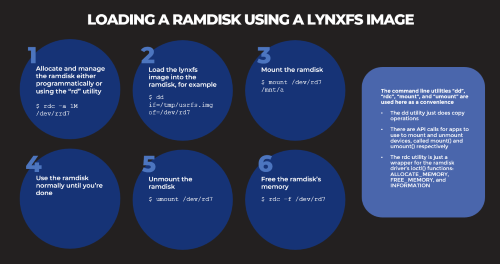Adjusting System Functionality and Capabilities in LYNX MOSA.ic
I recently set up a demo to showcase how a customer can use subjects, also known as rooms, like containers. What I mean by that is that software...
6 min read
 Ian Ferguson | VP Marketing
:
Nov 14, 2019 10:49:00 AM
Ian Ferguson | VP Marketing
:
Nov 14, 2019 10:49:00 AM

Lynx Software Technologies has built and supported real-time operating systems (RTOSes) since 1988. We have witnessed hardware and embedded software technologies evolve and have supported our customers through the design, development, integration, certification, deployment, and support of software systems across mission-critical applications in AVIONICS, INDUSTRIAL, AUTOMOTIVE, UNMANNED SYSTEMS, DEFENSE, SECURE LAPTOPS, CRITICAL INFRASTRUCTURE, and other markets.
We have learned that over the years that, depending on the type of system being built, our RTOS products may not always provide the best fit. And that’s OK. We want you to choose Lynx products because they make the most sense for your project and understanding your options is critical to that process. That is why we would like to answer the 2 most common questions we get from prospective customers:
Studies are typically published annually from surveys of embedded software engineers. One of the more popular and accessible studies is the AspenCore Embedded Markets Study (beginning slide 48). There are also reports created by analyst firms, such as VDC Research. Common online sources, such as Wikipedia’s RTOS comparison list, are sometimes out of date, so we decided to outline a list of popular RTOSes here (a more detailed list with further information can be found below).

As mentioned, Lynx has been building RTOSes for more than 30 years. Our LynxOS-178® RTOS is a native POSIX®, hard real-time partitioning operating system developed and certified to FAA DO-178B/C DAL A safety standards. It is the only Commercial-off-the-Shelf (COTS) OS to be awarded a Reusable Software Component (RSC) certificate from the FAA for re-usability in DO-178B/C certification projects.
LynxOS-178 is the primary host for real-time POSIX and FACE™ applications within the LYNX MOSA.ic™ development and integration framework. LynxOS-178 native POSIX implementation satisfies the PSE 53/54 profiles for both dedicated and multi-purpose real-time as well as FACE applications. LynxOS and LynxOS-178 have been deployed in millions of safety-critical applications worldwide, including multiple military and aerospace systems.
There are several ways to group providers of real-time operating systems. We have chosen to distinguish between semiconductor companies which provide complementary hardware technology and software companies.
Based on our research and experience, FreeRTOS is the most widely deployed real time operating system. Given that this article is designed to be a reference guide with minimal judgments, we simply decided to list them in alphabetical order. Also note that this is not a list of “The Best RTOSes." It is, instead, a more complete list of popular RTOSes being used for various IoT and embedded projects.
Some may ask why RTLinux is missing. The answer depends on the system you are building. If that system is a car driving along a freeway at 70mph, an unmanned aerial vehicle, or an industrial robot on a production line, then the system must be guaranteed to respond to a particular condition in a very short space of time. FreeRTOS can show some examples of it taking less than 100 clock cycles; with the speed of today's MCUs, that is in the microseconds range. So for safety critical systems, we don't see the OS that drives the safety critical fundamentals of the platform using any form of Linux. We do, however, see Linux as an extremely effective way to bring in a broad set of functionality into the system, with both Linux and an RTOS or bare-metal environments being run concurrently on a secure hypervisor. If you feel we are missing an RTOS that should be included on this list, please let us know by emailing us at inside@lynx.com
|
Operating System |
Company Name |
Per Unit Royalties? |
Summary |
|
Yes |
DDC-I is a privately held company founded originally in Denmark but now based out of Phoenix, AZ. The Deos RTOS targets those in the A&D market requiring DO-178 certification. We have received limited customer feedback on the product. |
||
|
No |
Segger is a German company with a long track record of delivering debugging equipment for embedded systems. embOS has been available for quite some time and is free for non-commercial use. The commercial model is royalty free, with the customer paying for access to the source code for distribution rights in production systems. Focus is on industrial and automotive, with certifications for the appropriate safety assurance standards in those areas. |
||
|
Owned by Amazon since 2017 |
No |
As mentioned above, FreeRTOS is thought to be the most adopted RTOS for designs. It supports a diverse range of processor architectures and the acquisition by Amazon has driven increased investment in engineering. More software development now in AWS Greengrass to directly target platforms based on this RTOS. |
|
|
Yes |
Privately owned company based out of Santa Barbara, California. Cadence invested in the company in early 2019. Historical competitor of Lynx in the A&D segment. |
||
|
Arm (Acquired by SoftBank in 2016) |
No |
This is an RTOS made available royalty free for Arm Cortex-M based microcontrollers. Does not appear to be a core focus area for the company on a forwarding-going basis. |
|
|
Yes |
Privately held company founded in 1985 (formerly LynuxWorks) and based out of San Jose, California. Historical focus on A&D markets for customers needing DO-178 certification, with growing expansion into Automotive, Industrial, and IT Infrastructure. Native POSIX® RTOSes + Virtualization technologies. |
||
|
No |
Good base functionality. The challenge is that given the ownership, end OEMs are concerned about being locked-in to a specific silicon supplier. |
||
|
Nucleus |
Mentor Graphics (Acquired by Siemens in 2017 |
No |
Going back a decade, this was the RTOS for the embedded space with a (pay for) source, royalty-free model. Its presence appears to have slowly declined as Mentor looked to monetize around other software, including the core staple of EDA. |
|
Yes |
German company headquartered in Mainz that has been historically focused on industrial and automotive markets. The RTOS seems to be less of a focus for the company on a forward going basis, with more activity around the hypervisor and Linux technologies. |
||
|
QNX (Wholly owned subsidiary of Blackberry) |
Yes |
Neutrino is well known for its position in the automotive market as the dominant operating system for combustion engine management systems. Looking to extend this into new automotive segments. |
|
|
SAFERTOS® |
No |
SAFERTOS® is a safety critical RTOS supporting certification for medical, automotive, and industrial applications. It has been independently pre-certified to IEC 61508 SIL3 and ISO 26262 ASILD by TÜV SÜD. Based on the functional model of FreeRTOS, users are able to upgrade from FreeRTOS to SAFERTOS using a well supported migration path. |
|
|
Express Logic (Acquired by Microsoft in 2019) |
No |
Supports of a wide set of processor architectures. Still early to understand Microsoft’s specific plans for this operating system, but, so far, there seems to have been little change. |
|
|
µC/OS |
Micrium (Acquired by Silicon Labs in 2016) |
No |
Micrium is a subsidiary of Silicon Labs. We are unclear of µC/OS’s long-term direction for continued support outside Silicon Lab’s specific product needs. |
|
Wind River (Divested from Intel in July 2018) |
Yes |
The historical leader in embedded operating systems. Offers the RTOS and a Linux product. VxWorks had historical footprint in networking, which appears to have eroded with the rise in Linux. Also present in a range of industrial and aerospace markets. Recently acquired a Linux security company, Starlab (2020). |
|
|
Linux Foundation |
No |
An open source project hosted by the Linux Foundation. Intel was originally backing this quite strongly and we have quite high hopes for the adoption of this technology. It has been slower than several of us imagined, but NXP has recently been contributing code. |
Before you choose an RTOS, we strongly recommend that you make sure you absolutely need one. Real-time operating systems, by their very nature, impose software architectural structure, programming interfaces and footprint constraints that your project may or may not need. Too often, we see builders of embedded systems commit to an RTOS before fully evaluating their needs and considering the wide range of options before them. That is why we have published the following guides:
The right solution may end up being multiple operating systems running on one heterogenous platform. This has been the case in equipment like smartphones for some time. We envision this becoming the norm for a significantly broader set of industrial IoT, A&D, and automotive platforms, as system architects look to blend the real-time determinism with the deep software ecosystems of Windows or Linux environments.
Lynx has over 30 years’ experience in helping customers across avionics, automotive, and industrial markets to efficiently realize their complex safety- and security-critical embedded software systems. To learn more about how to leverage a heterogeneous design for your next project, please direct your inquiries to inside@lynx.com or fill out the form by clicking the button below, and a representative will reach out to you within 1-2 business days.

I recently set up a demo to showcase how a customer can use subjects, also known as rooms, like containers. What I mean by that is that software...

Based on several customers inquiries the purpose of this blog is to outline how to Allocate memory to a RAM disk Mount and unmount a RAM disk ...

Not many companies have the expertise to build software to meet the DO-178C (Aviation), IEC61508 (Industrial), or ISO26262 (Automotive) safety...